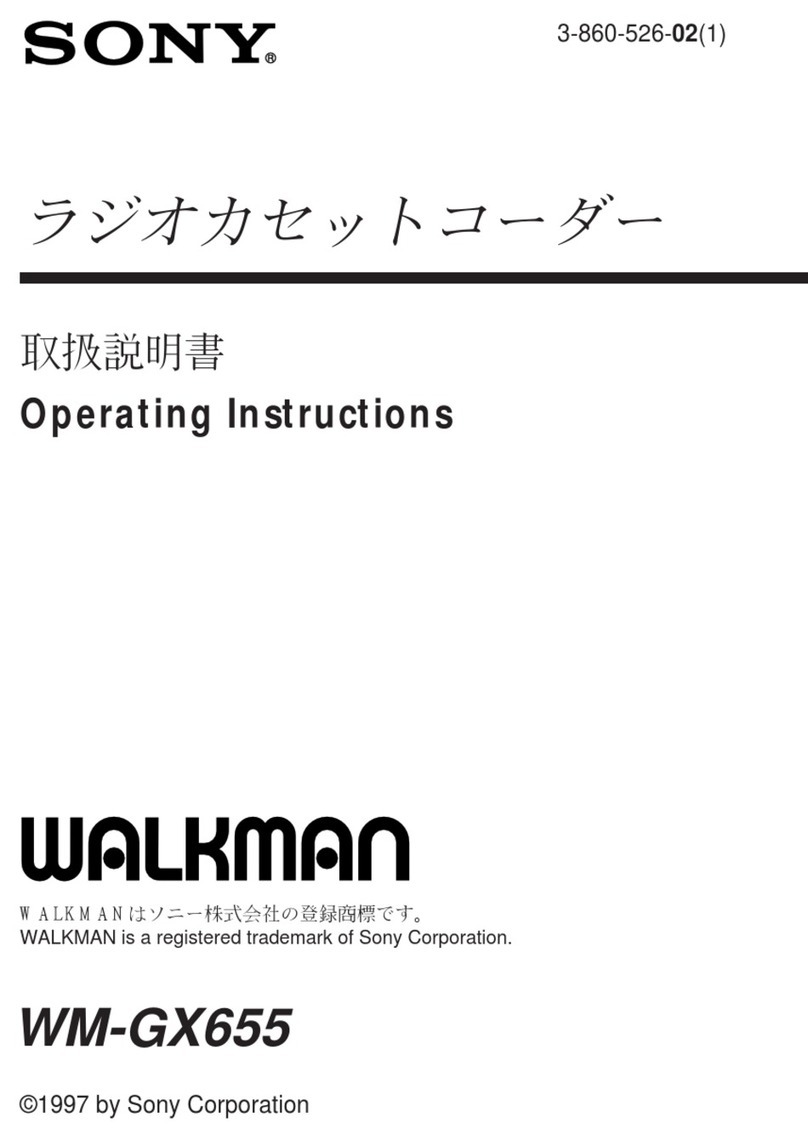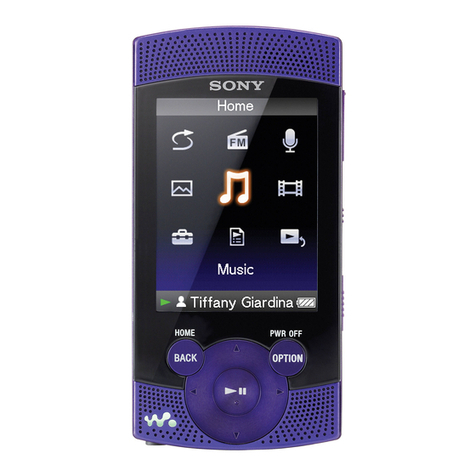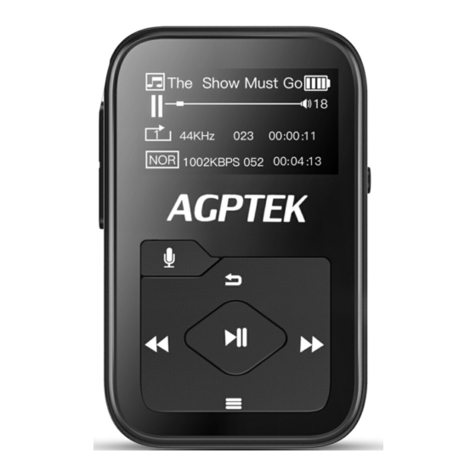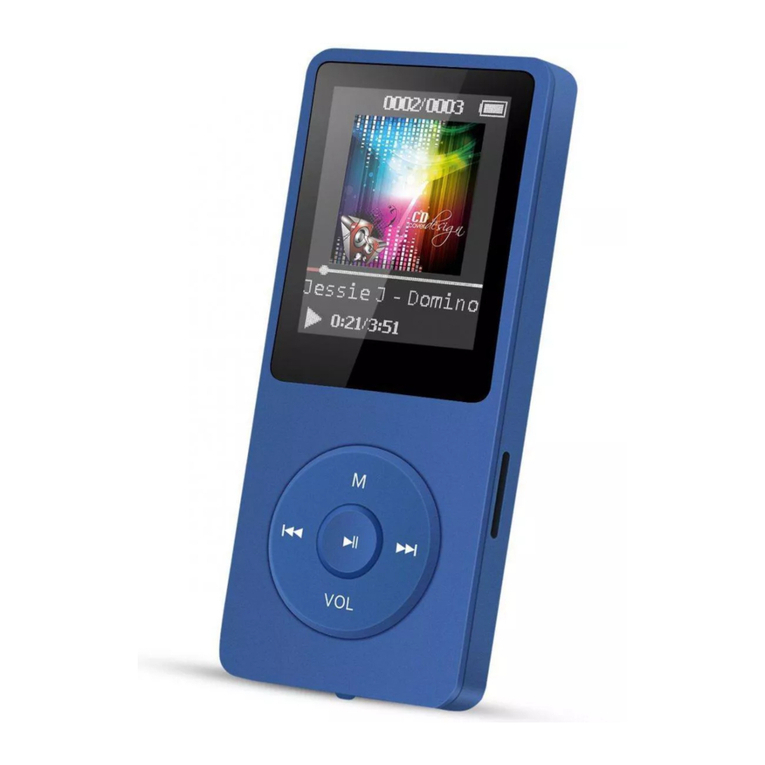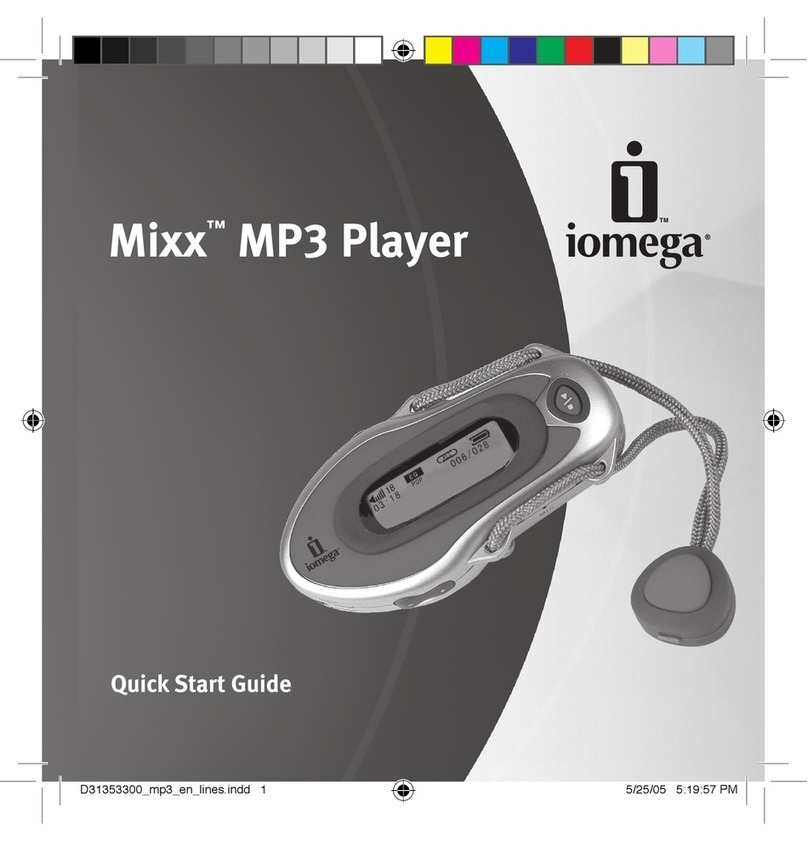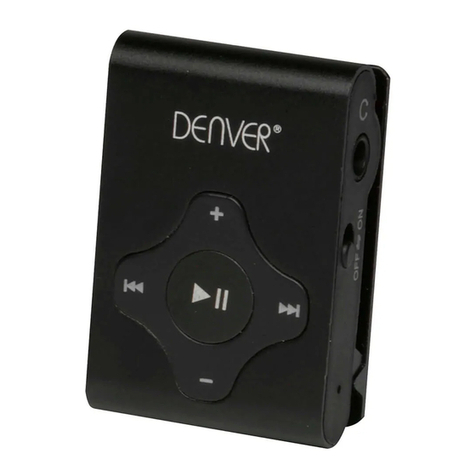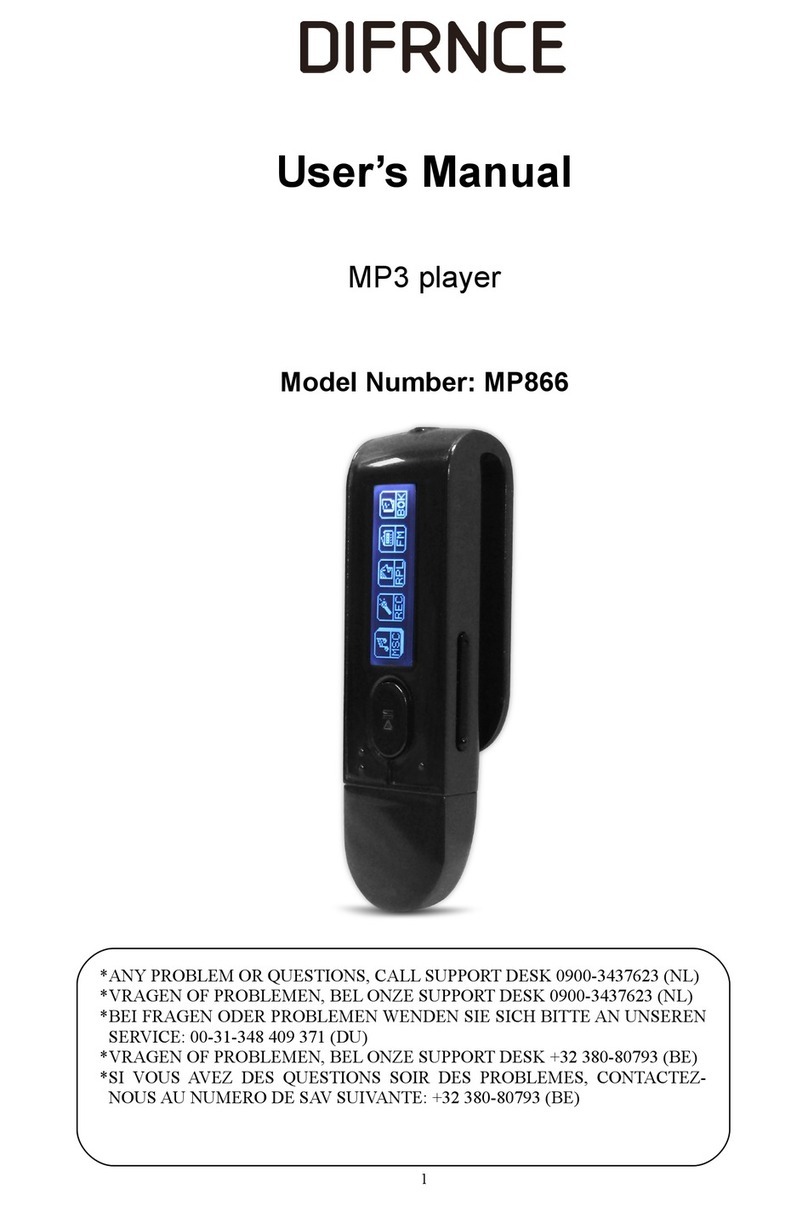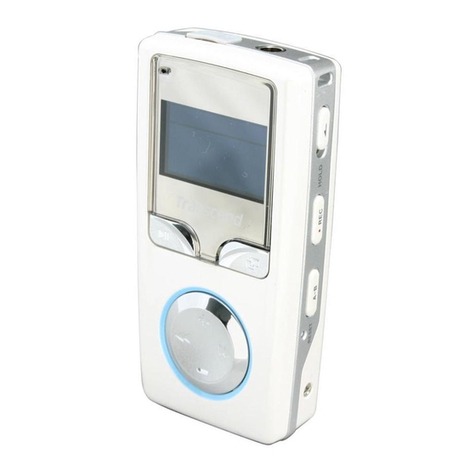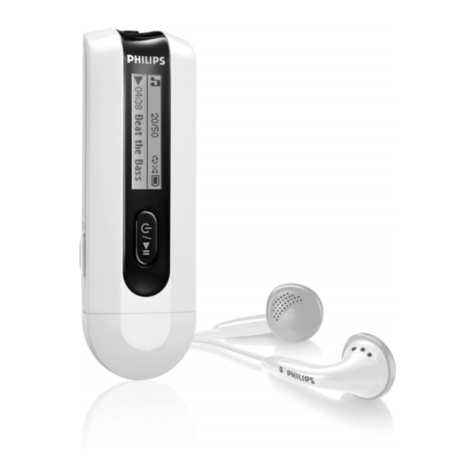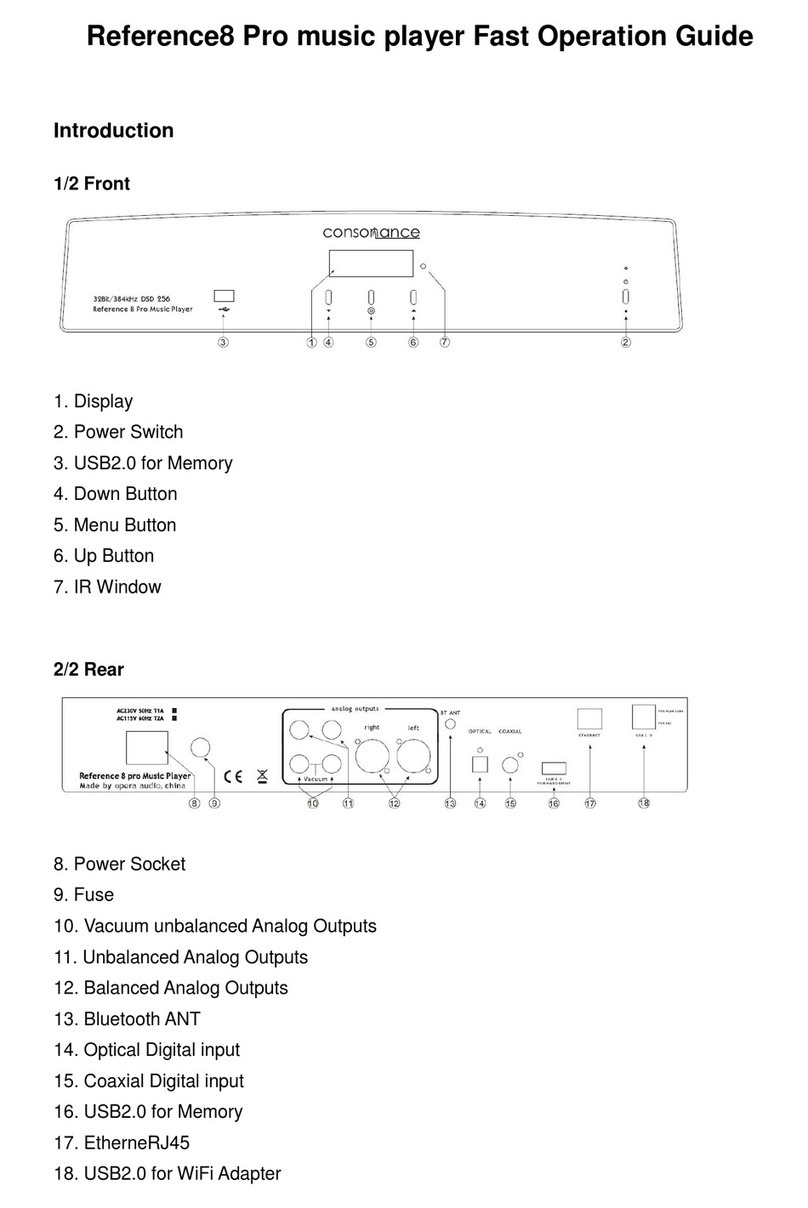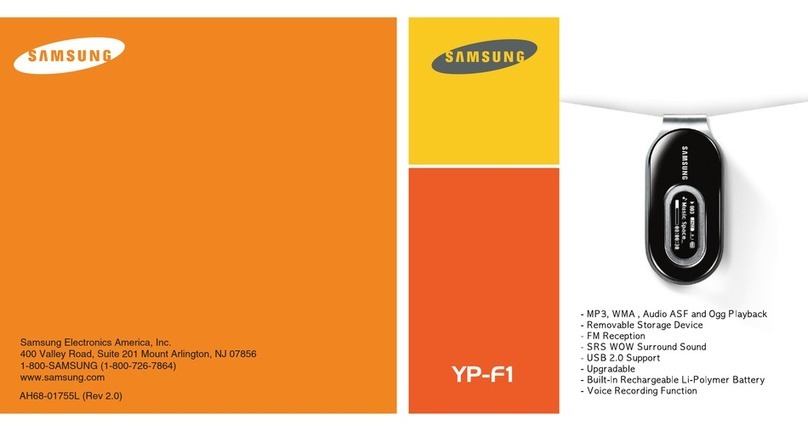Mackenzie MacFi-mp User manual

MACKENZIE LABORATORIES, INC.
1163 Nicole Court
Glendora, CA 91740 USA
Tel: (909) 394-9007 Fax: (909) 394-9411
Email: [email protected]
Web: www.macklabs.com
MP3 DIGITAL AUDIO RECORD/PLAY SYSTEM
User's Manual
Version 1.0 Revised 05/14/2003
Doc 99-20-043 - $25.00

2
General Safety Instructions
Always follow these basic safety precautions when using the system:
1. Read carefully and understand all instructions.
2. Follow all warnings and instructions marked on the product.
3. DO NOT block or cover ventilation slots and openings.
4. DO NOT place the product in a closed enclosure or cabinet unless
proper ventilation is provided.
5. Never spill liquid on the product or drop objects into the ventilation
slots and openings. Doing so may result in serious damage to the
components.
6. Repair or service must be performed by a factory authorized repair
facility.
7. DO NOT staple or otherwise attach the power supply cord to
building surface.
8. DO NOT use the product near or in wet or damp places, such as
wet basements.
9. DO NOT install during lightning storm.
10. Never touch un-insulated wires or terminals unless the unit is
disconnected from both power and the rest of the phone system.
11. Use Caution when installing or modifying configuration switches or
control lines.
12. The unit must be securely attached to a wall board, rack or table
mounted.

3
Table of Contents
1. OVERVIEW..................................................................................5
1.1 Features and Capabilities......................................................5
1.1.1. MacFi-mpe - Enhanced Features ......................................6
General Specifications .....................................................................6
2. INSTALLATION & CONFIGURATION..........................................8
2.1 Installation Steps...................................................................8
2.2 Hardware Configuration ........................................................8
2.2.1. Power................................................................................8
2.2.2. Configuration Switches......................................................9
2.2.3. Connector 1 ....................................................................12
2.2.4. Connector 2 ....................................................................13
2.2.5. Audio In Level ................................................................. 13
2.2.6. Audio In Mic ....................................................................13
2.2.7. Audio In Line ...................................................................13
2.2.8. Audio Out Level...............................................................13
2.2.9. Audio Out Line ................................................................16
2.2.10.Audio Out SPKR ............................................................. 16
2.3 Pushbutton & LED Configuration......................................... 16
2.3.1. Overdrive Indicator.......................................................... 16
2.3.2. Audio Sense Indicator .....................................................17
2.3.3. Record Indicator.............................................................. 17
2.3.4. Record Setup Button....................................................... 17
2.3.5. Start/Stop Button............................................................. 17
2.3.6. Select Button................................................................... 18
2.3.7. Message Number and Status Display .............................18
3. OPERATION ..............................................................................20
3.1 Recording - Local ................................................................20
3.2 Recording - Remote Control................................................20
3.3 Playing-Local.......................................................................21
3.4 Playing-Remote Control ......................................................21
3.5 Memory Clear/Test.............................................................. 22
3.6 Erase Message ...................................................................22
4. MacFi-mpe ENHANCED FEATURES.........................................23
4.1 RS-232 (Serial) Command List............................................23
5. WARRANTY, SERVICE & RETURNS........................................24
5.1 Warranty Coverage: ............................................................24
5.2 What we ask you to do: ....................................................... 25
5.3 What this warranty does not cover: ..................................... 25

4
Shipping Container Contents
The following items should be found in the container of MacFi-mp, MP3
Digital Audio Record/Play System:
▪MacFi-mp System
▪Installation and User Guide
▪Set of four rubber feet
Hardware Configurations
▪MacFi-mp 40; 99 messages, 40 minutes
▪MacFi-mpe 40; 99 messages, 40 minutes, RS-232 control, Sync
relay
Optional Accessories:
▪Power Pack, 12 VDC, 1.0 amp, 115 V 50/60Hz, Order: MacFi-mp-PS
▪Standard Rack Mount Kit, Order: MacFi-mp RM-KIT
▪Enhanced Rack Mount Kit, Order: MacFi-mp RM-KIT-E
▪RS-232 Cable for Enhanced Unit, Order: MacFi-mpe-CBL
▪Weather Resistant Speaker with Mount, Order: CS4
▪Microwave Motion Sensor, Order: MS-2
▪Input Control Module, 25 start inputs to RS-232, Order: ICM-25

5
1. OVERVIEW
1.1 Features and Capabilities
The Mackenzie MacFi-mp family is the most cost effective series of
MP3 Digital Audio Record / Play Systems available for industrial
usage. Backed by Mackenzie’s years of system design experience,
MacFi-mp offers a great deal of functionality in a compact and
inexpensive package.
Messages are user recordable via microphone or line input through a
straight forward user interface located directly on the unit. Simple
parallel controls for 8 messages are available on terminal connectors.
Record and Stop inputs and a Play relay output are also accessible
via terminals.
The MacFi-mp offers up to 99 messages and 40 minutes of MP3
audio. MP3 supports up to 15kHz bandwidth and 80 dB of dynamic
range. All 99 messages are accessible from the user interface on the
MacFi-mp with 8 remote start inputs accessible via the remote
activation pluggable terminal. Dynamic Message Length (DML)
technology has been incorporated in the MacFi-mp allowing each of
the messages to be of different duration. DML also provides for
replacement messages to be a different length than the original,
maximizing memory efficiency and compatibility with future
applications.
The MacFi-mp retrieves stored audio data from non-volatile flash
memory, eliminating the need for battery backup, and delivers superb
sound quality.
The MacFi-mp offers several different playback modes to
accommodate different applications. Standard, Play once per
closure, Play while active, and Retrigger allow the MacFi-mp to be
used with existing on site control circuitry. Message repetition and
delay between message settings are user selectable as well.
The space saving built-in 4 watt power amplifier is perfect for most
direct to speaker applications as it eliminates the need for additional
hardware.
The MacFi-mp’s small size, industrial construction and the absence
of moving parts make it ideal for automatic unattended operation,
especially in harsh environmental or mobile conditions. An optional
1U rack mount adapter is also available.

6
1.1.1. MacFi-mpe - Enhanced Features
The MacFi-mpe version adds the following features to the
standard unit:
-RS-232 (Serial) control of recording and playback
-RS-232 (Serial) download of MPEG layer 1, 2 or 3 (MP3) files.
-Synchronization Relay
-Front mounted controls
General Specifications
Audio Coding:
Recording: MPEG 1, Layer 3(Variable Bit Rate)
Playback: MPEG 1, Layer 3(VBR) or MPEG 1,
Layer 1, 2 & 3 via audio file transfer
capability of the MacFi-mpe
Audio Quality:
Dynamic Range: 80dB, Typical
Signal to Noise: 80dB, Typical
Frequency Resp.: 50Hz to 15kHz
THD: < 0.5% at 1kHz, Typical
Audio Input:
Line: 10k ohm, RCA
Mic: 1.5k ohm, 1/8" mini jack, Low Z
Level: +4dBm max., adjustable potentiometer
Audio Output:
Line: 600 ohm(+4dBm max.), transformer
isolated, RCA
Amplified: 4 watts into 8 ohm, 2 pin pluggable
terminal
Level: Adjustable potentiometer
Audio Memory:
Type: FLASH EPROM
Capacity: 32MB, 40 min local record
Power Requirement:
Input Voltage: 12vdc
Current: 1 amp for Power Amp, 250mA w/o Amp
Connection: 2 pin pluggable terminal
Manual Control Interface:
Pushbuttons: Record, Start/Stop, Select.
LED's/Display: Overdrive, Audio Sense, Record Status
LED's, message number display.

7
Remote Activation I/O:
Control Inputs: Record, Stop, 8 individual message
Start contacts.
ICM-25(Option): Add to the MacFi-mpe for 25 more start
inputs per module.
Status Outputs: Playing, Sync(MacFi-mpe version only)
Output Type: Dry relay contact, 1A @24VDC non-
inductive load
Connection: Pluggable terminal
Mechanical:
Package: 3 Way wall mount chassis,
10" W x 8" D x 1.5" H
Material: 18 gauge cold rolled steel chassis; black
painted finish, white silkscreen
Rack mount(option): 1U adapter
Regulatory Agency Approvals:
FCC, Part 15, Class A; UL/CSA approval on external power
pack(sold separately)
MacFi-mpe Enhanced Features:
Serial Interface:
Type: RS-232
Mode: 9,600 or 115,200 baud,
8 data bits, 1 stop bit,
no parity, no flow control
Commands: Play, Record, Stop, File Download,
Status, etc. (See Table 4.1)
Connection: 3 pin pluggable terminal
Sync Input:
Interface: 10k ohm, RCA
Mode: Audio sensor detects tones 100mS in
duration

8
2. INSTALLATION & CONFIGURATION
This section provides complete instructions for mounting the
MacFi-mp, MP3 Digital Audio Record / Play System on a wall or
table. It also illustrates all interface requirements to auxiliary
equipment, including inputs and outputs. Configuration switch
settings are provided.
2.1 Installation Steps
These are the general steps for installation.
1. Find a space on the wall or table. For table top applications,
install included rubber feet. Allow approximately 6 inches in
front of, and 6 inches above the unit for user access to the
controls and wiring.
2. Mount the unit to the selected place with its wiring at least
18” away from power supply or other equipment that
generates electrical noise.
3. Set DIP switches to the desired operation.
4. Connect audio inputs and outputs.
5. Connect control inputs and outputs.
6. If you are using the optional power supply, make sure there
is a standard, non-switched electrical outlet available.
7. Connect and apply power.
8. Test unit operation.
2.2 Hardware Configuration
2.2.1. Power
1 2
Two terminal pluggable connector.
1 12 VDC at 1 amp
2 Ground
Power LED Off No power supplied to unit
On Power on, system OK
Green LED which
indicates that power is
supplied to the unit and
operating correctly

9
2.2.2. Configuration Switches
8 position DIP Switch: UP ( ) position is OFF.
DOWN ( ) position is ON.
This user adjustable dip switch is provided to allow the user to
tailor the operation of the MacFi-mp to meet their demands.
NOTE: Dip switch settings are only established at system
power up. To change settings, disconnect power, change
the dip switch settings, then re-apply power.
12
Play activated message one
times
Play activated message two
times
Play activated message three
times
Number of Plays
For applications where
messages need to be
repeated due to ambient
noise or for clarity. Global
setting for all messages.
When message is
activated through the
remote activation
connector, it will play the
programmed number of
times.
Play activated message four
times*
*This selection may be customized by users of the MacFi-mpe
by using the PLS command for a range of 1 - 99 plays.
34
One second pause between
plays
Five second pause between
plays
Ten second pause between
plays
Pause Between Plays
When the number of
plays is more than one,
this configuration will
insert a pause of the
selected duration
between each play.
Thirty second pause between
plays*
*This selection may be customized by users of the MacFi-mpe
by using the PAS command for a range of 0 - 99 seconds or 0 -
99 minutes.

10
56
Standard operation - details
below
Play one sequence per
closure -details below
Play while active - details
below
Play Method
Defines playback mode
of Message sequences.
Message sequences are
comprised of the
message material,
number of plays and
delay between plays. Re-trigger - details below
Standard Operation: A momentary contact closure at a start
input causes the device to play one sequence of the message
corresponding to that input. A sequence is specified by the
number of message plays and the amount of delay between
each message, as selected by the dip switches. If a contact is
maintained active, the system will continuously play that
sequence repeatedly until the input is released at which time the
system will finish the current playback sequence and then stop.
If multiple inputs are held active the system will play one
sequence of the first message and then cycle through any other
active messages sequentially, based on the order which they
were activated. The message corresponding to the lower input
number will have priority should multiple inputs be activated at
exactly the same time.
If a momentary contact closure is provided, for the same or any
other message, while a sequence is playing and it is released
prior to the ending of the current message play, it will be
ignored.
Play one sequence per closure: If an activation input is
maintained, the system will only play the message sequence
one time. The MacFi-mp will wait for the input to go inactive for
100ms before it will recognize that input for subsequent
message activations. Other play activations will be serviced
normally, even with another input held active indefinitely.
This mode supports message queuing. Message queuing allows
the user to input multiple, momentary activation’s to the MacFi-
mp, causing each of the messages to be played in the order
they were received. The queue length is 16 sequences
maximum, including the message which is playing. A single

11
message may be queued more than once. Any activation issued
once the queue is filled will be ignored.
A stop command will stop the message which is currently
playing, and when released, the next message in queue will
begin playing.
If multiple inputs are held active and maintained, the system will
play each message sequence once then stop.
Play while active: Upon receiving a maintained input control
signal, the message starts and continues to play for the duration
which the control signal is held active. If the input signal is
removed prior to the end of the message sequence, the system
will immediately stop playing that message.
If the input is sustained after the current sequence has
completed, another sequence will be initiated. If the input is
removed during the delay time after the final message play in
the sequence, another sequence activation will not occur.
If multiple inputs are maintained active while in this mode, the
system will only play the active message of the highest priority
and then repeat. This mode does not support queuing.
Re-Trigger: This mode allows playing messages to be
interrupted by another incoming message, or another activation
of the same message. If a message is currently playing and
another message activation is received, the currently playing
message will be terminated and the new message will be
played.
A maintained message activation will only play the sequence
one time and then stop. If multiple inputs are activated at exactly
the same time, only the lower numbered message of the highest
priority will be played. This mode does not support queuing.

12
7Disable
Enable
Play Next
Enabling Play Next allows Start 8 input
(Connector 1, Pos. 9) to initiate playback of the
next valid message sequence. The first start
activation after power on will play message 1. All
operation modes are supported and other start
inputs (1 - 7) are disabled.
8Disable
Memory Protect
Allows the user to lock message memory so that
messages may not be accidentally overwritten. Enable
2.2.3. Connector 1
12 position pluggable terminal strip. Use for remote activation of
message playback, stopping messages, and playing relay
output. Activation can be made through mechanical contact or
open collector driver. 3mA activation current.
1 Common ground for all inputs
2 Start 1 Input, connect to common for message 1 playback
3 Start 2 Input, connect to common for message 2 playback
4 Start 3 Input, connect to common for message 3 playback
5 Start 4 Input, connect to common for message 4 playback
6 Start 5 Input, connect to common for message 5 playback
7 Start 6 Input, connect to common for message 6 playback
8 Start 7 Input, connect to common for message 7 playback
9 Start 8 Input, connect to common for message 8 playback
10 Stop Input, connect to common to stop message playback or
recording
11 Play Relay Output, Common
12 Play Relay Output, Form A, connects to position 11 when
playing.

13
2.2.4. Connector 2
3 position terminal connection. Used for remote activation of
recording.
1 Record Input, connect to common on Connector 1 to enter
record setup mode.
2 Future Use
3 Future Use
For remote recording procedure, reference section 3.2.
2.2.5. Audio In Level
Potentiometer to adjust record level. +4dBm maximum input
level.
2.2.6. Audio In Mic
Microphone input for recording messages. Mono. 1/8” mini jack.
Up to 1.5k ohm impedance. This specification is compatible with
most consumer grade microphones(Radio Shack
Omnidirectional Dynamic P/N 33-2001). NOTE: Mic input and
Line input may not be used at the same time. Please make
sure Line input is disconnected on the unit for the
microphone to work.
2.2.7. Audio In Line
Line level analog audio input for recording messages. Mono.
RCA connection, 10kohm impedance. Compatible with the
unbalanced analog outputs of most tape decks, CD players,
DAT players, etc. NOTE: Line input and Mic input may not be
used at the same time.
2.2.8. Audio Out Level
Potentiometer to adjust playback level. Range is continuous
from -infinity to +4dBm.

14

15

16
2.2.9. Audio Out Line
Line level analog audio output for playing messages. Mono.
Transformer isolated, RCA connection, 600 ohm impedance.
Compatible with the unbalanced analog inputs of most audio
equipment.
2.2.10. Audio Out SPKR
Bridged, mono speaker output for playing messages. 2 position
terminal connector. 4 watts into 8 ohms or 6 watts into 4 ohms.
CAUTION: Referencing either of the speaker output terminals to
ground will cause incorrect operation and may damage the unit.
Always connect the speaker directly across the supplied
terminal connections.
2.3 Pushbutton & LED Configuration
Pushbuttons and LED’s are located on the top of the MacFi-mp
allowing easy and convenient message recording and playback.
The following describes use of the Status and Message
Sections.
2.3.1. Overdrive Indicator
Off Input is not overdriving the
system
On Input is overdriving the system,
reduce Audio In Level
This red LED monitors
the level of the recording
input. Overdriving the
system will cause audio
to clip, adversely
effecting sound quality.
Monitor the input
material and set the
input level just below
overdrive for the best
results.

17
2.3.2. Audio Sense Indicator
Off Audio signal is low or no signal
present
On Signal present
This green LED monitors
the presence of audio on
recording input. This is
designed to indicate that
the audio level is
optimum for system
performance. It is not an
absolute reference that
audio is present or not.
2.3.3. Record Indicator
Cause
Off System not in
record setup or
recording.
N/A
Blink Record setup mode Record setup button
This red LED
indicates that
The MacFi-mp
is in record
setup mode or
recording. On Recording Start/Stop button
2.3.4. Record Setup Button
This push button configures the MacFi-mp for record mode.
Pressing this button will cause the record LED to blink, verifying
the MacFi-mp is in record setup mode. Depressing this button
while still in record setup mode will exit this mode and turn off
the record LED. Pressing the button in the middle of the
recording process will have no effect. NOTE: If you have
difficulty recording, verify Memory Protect, Configuration
Switch 8 is OFF( ).
2.3.5. Start/Stop Button
This button will either start or stop the current message. This is
applicable to either record or play modes. Depressing Start/Stop
button while playing or recording will exit the mode and return
system to idle.
If a message is selected for playback, with its number displayed
on the Message Number Display, pressing this button will
initiate the message play. Pressing it again, while the message
is playing, will stop the message play.

18
If a message is setup for recording, the record LED will be
blinking and the message location will be displayed on the
Message Number Display, pressing this button will initiate the
recording process. Pressing it again, with the recording in
process, will stop the recording.
Pressing this button with no LEDs blinking and no message on
the Message Number Display will have no effect.
NOTE: Pressing and holding the Start/Stop button during
power up will set the configuration settings to their default
value. Applies to the DLY, PAS, PLY and 9,600 baud rate of
the MacFi-mpe.
2.3.6. Select Button
This button selects the message for recording or playing.
Depressing this button sequences through the individual
message positions, represented by the Message Number and
Status Display. The Select button may be used during record
setup or to initiate playback mode when the system is idle.
NOTE: Holding the Select Button during message select
causes the message number to increase by tens to
expedite navigating through the 99 messages.
2.3.7. Message Number and Status Display
These two seven segment LED’s indicate which message is
selected and provide a variety of status indications for the
MacFi-mp. See the table below for an explanation of the
different modes of the display.

19
Display Reads Cause
Cycles through all
segments
No messages to select for playback.
1 - 99 Message number playing or recording
Both Decimals Blink Message location is occupied
Right Decimal Solid Delay, Pause or Repeat configuration
has been modified on MacFi-mpe
FC Bad Block Memory Test*
Hi MacFi-mpe serial port set for 115200**
Lo MacFi-mpe serial port set for 9600**
* Hold Record pushbutton during power up to start Bad Block
Memory Test.
** Hold Sync pushbutton on MacFi-mpe during power up to
toggle between baud rates.
NOTE: In play mode, Select button circulates through only valid
recorded message locations.

20
3. OPERATION
3.1 Recording - Local
Local recording is achieved through the LED’s and buttons
located on the top of the MacFi-mp unit. Please reference the
Manual Button & LED Configuration section of this manual for
additional information on functions.
Step 1 – Make all desired power, audio in, audio out,
configuration switch and I/O connections to the unit
and power up. Unit will initiate self test and default to
idle mode(approx. 2 seconds).
Step 2 – Depress Record Setup button, Record LED will blink
Step 3 – Use Select button to determine message location to
record to. Message Number Display shows the
selected message, both decimals blink when the
location is occupied.
Step 4 – Listen to record source through the audio output
and/or reference Sense and Overdrive LED's to verify
level.
Step 5 – Depress Start/Stop button to begin recording and start
audio source. Message and Record LED’s will remain
solid during recording.
Step 6 – Depress Start/Stop button to end recording and exit.
NOTE: Record Setup will time out after 1 minute
of inactivity.
3.2 Recording - Remote Control
Remote Control recording is achieved through the I/O
connections located on the endplate of the MacFi-mp unit. This
process is only applicable to the first eight (1 - 8) messages on
the system. Please reference the Hardware Configuration
section of this manual for additional information on available
connections.
Step 1 – Make all desired power, audio in, audio out,
configuration switch and I/O connections to the unit
and power up. Unit will initiate self test and default to
idle mode
Step 2 – Provide a maintained input signal between the Record
Input(Connector 2 terminal 1) and common(Connector
1 terminal 1), this will blink the Record LED.
This manual suits for next models
1
Table of contents
Other Mackenzie MP3 Player manuals



